Macaron
A macaron (/ˌmækəˈrɒn/ mak-ə-RON;[1][2] French: [makaʁɔ̃]) or French macaroon (/ˌmækəˈruːn/ mak-ə-ROON[3][4]) is a sweet meringue-based confection made with egg white, icing sugar, granulated sugar, almond meal, and food colouring. There is some variation in whether the term macaron or macaroon is used, and the related coconut macaroon is often confused with the macaron. In North America, most bakers have adopted the French spelling of macaron for the meringue-based item to distinguish the two. Stanford professor of linguistics Daniel Jurafsky describes how the two confections have a shared history with macaroni (Italian maccheroni). Jurafsky notes that French words ending with "-on" that were borrowed into English in the 16th and 17th centuries are usually spelled with "-oon" (for example: balloon, cartoon, platoon).[5] In the UK, many bakeries continue to use the term "macaroon".[6][7]
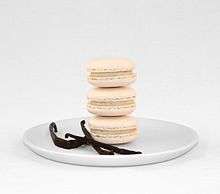 Parisian-style macarons (vanilla flavour) | |
| Alternative names | French macaroon |
|---|---|
| Type | Confectionery |
| Created by | The Italian chef of queen Catherine De Medici. |
| Main ingredients | Cookie: egg white, icing sugar, granulated sugar, almond powder, food colouring Filling: buttercream or clotted cream, ganache, or jam |
The macaron is traditionally held to have been introduced in France by the Italian chef of queen Catherine De Medici during the Renaissance. Since the 19th century, a typical Parisian-style macaron is presented with a ganache, buttercream or jam filling sandwiched between two such cookies, akin to a sandwich cookie. The confection is characterized by a smooth squared top, a ruffled circumference—referred to as the "crown" or "foot" (or "pied")—and a flat base. It is mildly moist and easily melts in the mouth. Macarons can be found in a wide variety of flavours that range from traditional (raspberry, chocolate) to unusual (foie gras, matcha).[8]
Past
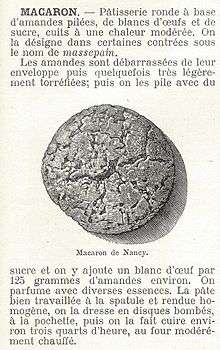
Macarons have been produced in the Venetian monasteries since the 8th century A.D. During the Renaissance, French queen Catherine de' Medici's Italian pastry chefs made them when she brought them with her to France in 1533 upon marrying Henry II of France.[9] According to Larousse Gastronomique the macaron was created in 1791 in a convent near Cormery. In 1792, macarons began to gain fame when two Carmelite nuns, seeking asylum in Nancy during the French Revolution, baked and sold the macaron cookies in order to pay for their housing. These nuns became known as the "Macaron Sisters". In these early stages, macarons were served without special flavours or fillings.[10]
It was not until the 1930s that macarons began to be served two-by-two with the addition of jams, liqueurs, and spices. The macaron as it is known today, composed of two almond meringue discs filled with a layer of buttercream, jam, or ganache filling, was originally called the "Gerbet" or the "Paris macaron." Pierre Desfontaines, of the French pâtisserie Ladurée, has sometimes been credited with its creation in the early part of the 20th century, but another baker, Claude Gerbet, also claims to have invented it.[5][11] French macaron bakeries became trendy in North America in the 2010s.[12]
Earliest recipe
Many Italian cookbooks of the 16th-century mention almond biscuits closely resembling macarons, albeit under different names. The earliest known recipe dates back to the early 17th century and appears to be inspired by a French version of the recipe.
To make French Macaroones
Wash a pound of the newest and the best Jordane Almonds in three or foure waters, to take away the rednesse from their out-side, lay them in a Bason of warme water all night, the next day blanch them, and dry them with a faire cloath, beat them in a stone morter, until they be reasonably fine, put to them halfe a pound of fine beaten Sugar, and so beat it to a perfect Paste, then put in halfe a dozen spoonefuls of good Damaske Rose-water, three graines of Ambergreece, when you have beaten all this together, dry it on a chafingdish of coales until it grow white and stiffe, then take it off the fire, and put the whites of two new laid Egs first beaten into froath, and so stirre it well together, then lay them on wafers in fashion of little long rowles, and so bake them in an Oven as hot as for Manchet, but you must first let the heat of the Oven passe over before you put them in, when they rise white and light, take them out of the Oven, and put them in a warm platter, and set them againe into the warme Oven & so let them remain foure or five houres, and then they wil be thoroughly dry, but if you like them better being moist, then dry them not after the first baking.— John Murrell, A Daily Exercise for Ladies and Gentlewomen (1617).[13]
Method
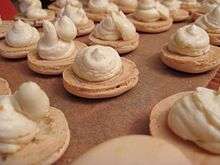
There are two main methods for making a macaron – the "French" method and the "Italian" method. The difference between the two is the way the meringue is made.
In the French method, egg whites are whisked until stiff-peaked meringue forms. From there, sifted, ground almonds and powdered sugar are folded in slowly until the desired consistency is reached. This process of knocking out air and folding is called macaronage.[14]
The Italian method involves whisking the egg whites with a hot sugar syrup to form a meringue. Sifted almonds and icing sugar are also mixed with raw egg whites to form a paste. The meringue and almond paste are mixed together to form the macaron mixture. This method is often deemed more structurally sound yet also sweeter and also requires a candy thermometer for the sugar syrup.
Either Italian or French meringue can be combined with ground almonds.[15]
A macaron is made by combining icing sugar and ground almonds into a fine mixture.[16] In a separate bowl, egg whites are beaten to a meringue-like consistency.[17] The two elements are then folded together until they are the consistency of "shaving foam", and then are piped, left to form a skin, and baked.[18] Sometimes, a filling is added.
Variations
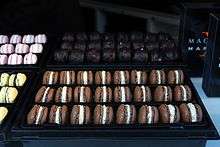
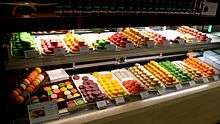
France
Several French cities and regions claim long histories and variations, notably Lorraine (Nancy and Boulay), Basque Country (Saint-Jean-de-Luz), Saint-Émilion, Amiens, Montmorillon, Le Dorat, Sault, Chartres, Cormery, Joyeuse and Sainte-Croix in Burgundy.
Macarons d'Amiens, made in Amiens, are small, round-shaped biscuit-type macarons made from almond paste, fruit and honey, which were first recorded in 1855.[19]
The city of Montmorillon is well known for its macarons and has a museum dedicated to them. The Maison Rannou-Métivier is the oldest macaron bakery in Montmorillon, dating back to 1920. The traditional recipe for Montmorillon macarons has remained unchanged for over 150 years.[20]
The town of Nancy in the Lorraine region has a storied history with the macaron. It is said that the abbess of Remiremont founded an order of nuns called the "Dames du Saint-Sacrement" with strict dietary rules prohibiting the consumption of meat. Two nuns, Sisters Marguerite, and Marie-Elisabeth are credited with creating the Nancy macaron to fit their dietary requirements. They became known as the 'Macaron Sisters' (Les Soeurs Macarons). In 1952, the city of Nancy honoured them by giving their name to the Rue de la Hache, where the macaron was invented.[21]
Japan
Macarons in Japan are a popular confection known as マカロン (makaron).[22] There is also another widely available version of makaron which substitutes peanut flour for almond and a wagashi-style flavouring. The makaron is featured in Japanese fashion through cell phone accessories, stickers, and cosmetics aimed towards women.[23]
Switzerland
In Switzerland, the Luxemburgerli (also Luxembourger) is a brand name of confectionery made by the Confiserie Sprüngli in Zürich, Switzerland. A Luxemburgerli is a macaron[24][25] comprising two disks of almond meringue[26] with a buttercream filling[27], though different flavours are also available. Luxemburgerli are smaller and lighter than macarons from many other vendors.
United States
Pastry chefs in the US have edited the classic cookie to include more traditional American flavors. Flavours of macarons available in the US have been known to include mint chocolate chip, peanut butter and jelly, snickers, peach champagne, pistachio, strawberry cheesecake, candy corn, salted pretzel, chocolate peanut butter, oatmeal raisin, candy cane, cinnamon, maple bacon, pumpkin, and salted caramel popcorn.[28]
Popularity
In Paris, the Ladurée chain of pastry shops has been known for its macarons for about 150 years.[29][30]
In Portugal, Australia, France, Belgium and Switzerland, McDonald's sells macarons in their McCafés (sometimes using advertising that likens the shape of a macaron to that of a hamburger).[29] McCafé macarons are produced by Château Blanc, which, like Ladurée, is a subsidiary of Groupe Holder, though they do not use the same macaron recipe.[29]
Outside of Europe, the French-style macaron can be found in Canada[31] and the United States.[32][33][34]
In Australia, Adriano Zumbo and his TV series MasterChef have contributed to the macaron becoming a popular sweet treat, and it is now sold by McDonald's in its Australian McCafe outlets.[35]
See also
- Alfajor, a similar Spanish confection
- Petit four
Notes
- "Definition of macaron in English". Oxford Dictionaries. Retrieved 16 April 2018.
- "Definition of macaron". Merriam-Webster. Retrieved 16 April 2018.
- "Definition of macaroon in English". Oxford Dictionaries. Retrieved 16 April 2018.
- "Definition of macaroon". Merriam-Webster. Retrieved 16 April 2018.
- Jurafsky (2011b).
- "Macaron vs Macaroon - What's in a name anyway?". Anges de Sucre. Retrieved 18 March 2020.
- "Macaroon or Macaron?". Miss Macaroon. Retrieved 18 March 2020.
- "Macaron". Dessert Eater. Archived from the original on 11 August 2013.
- "History of Macarons". Mad Mac LLC. Archived from the original on 5 February 2009. Retrieved 2 January 2010.
- Robyn Lee. "Introduction to French Macarons". Serious Eats.
- Elena Ferretti (30 November 2009). "Macarons, the Daddy Mac of Cookies". Fox News.
- Mary Chao (11 June 2014). "The French Macaron Trend". Democrat & Chronicle.
- John Murrell (1617). A Daily Exercise for Ladies and Gentlewomen (PDF).
- "French pâtisserie technique: Macaronage". Le Cordon Bleu.
- "How to cook perfect chocolate macarons". The Guardian.
- "Macaron troubleshooting tips". Better with Butter.
- "Macaroons". BBC.
- "Macaron Myth Buster: French or Italian?". The World of Anges. 22 February 2015.
- Nick Rider (1 May 2005). Short Breaks Northern France. New Holland Publishers. p. 135. ISBN 9781860111839.
- Cécile Teurlay (July–August 2003). "Montmorillon — Le musée du Macaron et de l'Amande" [Montmorillon — The Macaron and Almond Museum]. Musée de l'Amande et du Macaron (in French).
- "Maison des Soeurs Macarons > Notre Histoire ..." achatville.com (in French).
- Jean-Philippe Darcy (9 July 2010). "夏の新作マカロン" [Summer New Macaroons] (in Japanese). Fukui News. Archived from the original on 17 March 2012. Retrieved 8 May 2012.
- Anderson, Sarah (15 August 2015). "Destination JS: Macaron Edition". Japan Society. Retrieved 30 September 2015.
- Hubbeling, Christina (10 October 2009). "Wer macht die besten Macarons?" [Who makes the best macarons?]. Neue Zürcher Zeitung (in German). Retrieved 3 March 2014.
- Böhler, Guido (20 March 2010). "Macarons: wer macht die besten und schönsten?" [Macarons: who makes the best and most attractive?]. delikatessenschweiz.ch (in German). Retrieved 3 March 2014.
- Malgieri, Nick (21 July 1994). "Baking: How to Make a Macaroon". Los Angeles Times. Retrieved 3 March 2014.
- Kummer, Corby (30 March 2011). "Smackaroon! The Switzerland vs. France Cookie Smackdown". The Atlantic. The Atlantic Monthly Group. Retrieved 3 March 2014.
- Thomson, Julie R. (9 October 2012). "Americanized Macaron Recipes: French Cookies With American Flavors (PHOTOS)". HuffPost. Huffington Post. Retrieved 30 September 2015.
- Jargon, Julie (2 March 2010). "Mon Dieu! Will Newfound Popularity Spoil the Dainty Macaron?". The Wall Street Journal. Retrieved 29 December 2010.
- Reed, M. H. (29 January 2009). "Macaroon Delight". The New York Times. Retrieved 29 December 2010.
- Chesterman, Lesley (11 October 2008). "Macaron mania hits Montreal - finally!". The Gazette (Montreal). Archived from the original on 9 November 2012. Retrieved 29 December 2010.
- Denn, Rebekah (25 October 2009). "French macarons are sweet, light and luscious". The Seattle Times.
- Greenspan, Dorie (1 April 2010). "Macarons: New to The Easter Parade This Year". Los Angeles Times. Retrieved 29 December 2010.
- Neda Ulaby (12 February 2010). "Move Over, Cupcake: Make Way For The Macaroon". NPR. Retrieved 29 December 2010.
- Chavassieu, Olivia (15 April 2008). "Heaven on Earth". Sydney Morning Herald. Retrieved 7 March 2012.
References
- Meyers, Cindy (Spring 2009). "The Macaron and Madame Blanchez". Gastronomica. The Journal of Food and Culture. University of California Press. 9 (2): 14–18. doi:10.1525/gfc.2009.9.2.14. JSTOR 10.1525/gfc.2009.9.2.14.
- Jurafsky, Dan (16 November 2011b). "Macarons, Macaroons, Macaroni — The curious history". Slate. Archived from the original on 13 October 2013. (About the history of the macaron.)
- Jurafsky, Dan (16 April 2011a). "Macaroons, Macarons, and Macaroni". The Language of Food.
Further reading
- B. Clermont (1776), "Des Macarons; commonly called Macaroni-drops", The professed cook, or, The modern art of cookery, pastry, and confectionary, made plain and easy, London: W. Davis, OCLC 6194222, OL 7237714M
- Louise-Béate-Augustine Friedel (1811), Le confiseur impérial, ou, L'art du confiseur dévoilé aux gourmands, A Paris: Chez Henri Tardieu, OCLC 61172534, OL 25072827M
- Frances Crawford (1853). "Macarons". French confectionary adapted for English families. London: Richard Bentley.
- Emile Herisse (1893), "Macaroons", The art of pastry making, London: Ward, Lock, Bowden, OL 13878920M
External links
